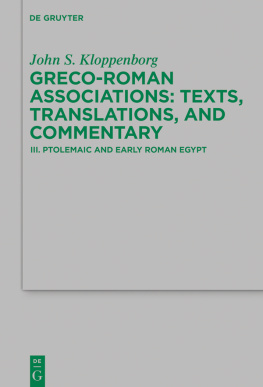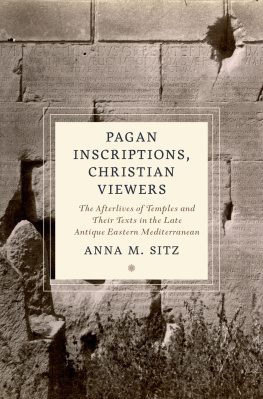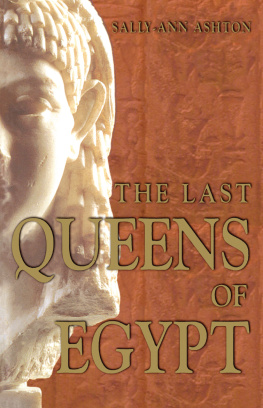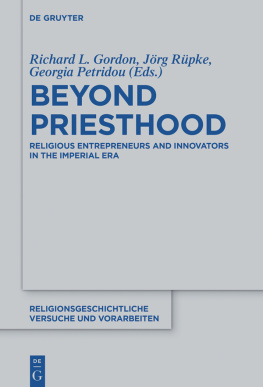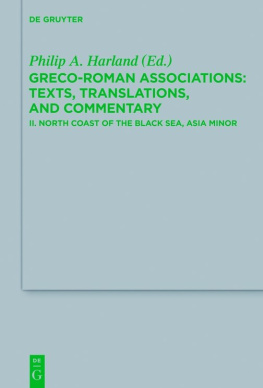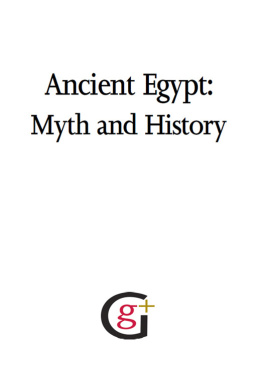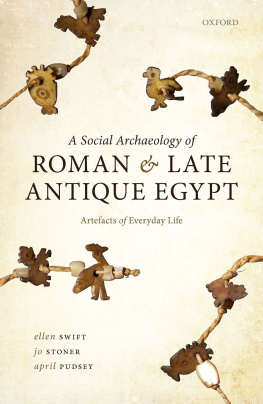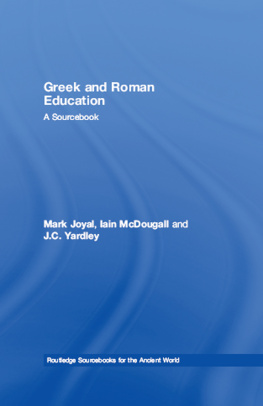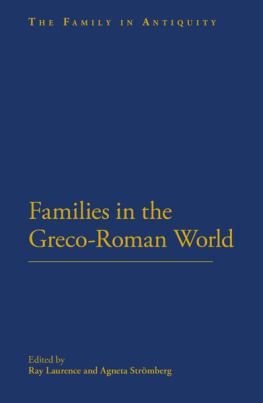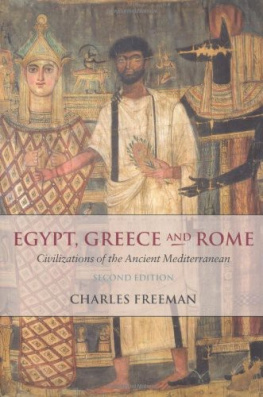Contents
Guide

John S. Kloppenborg
Greco-Roman Associations III:
Texts, Translations, and Commentary
Beihefte zur Zeitschrift
fr die neutestamentliche
Wissenschaft
Herausgegeben von
Matthias Konradt, Judith Lieu, Laura Nasrallah,
Jens Schrter und Gregory E. Sterling
Band 246

ISBN 978-3-11-070768-7
e-ISBN (PDF) 978-3-11-071039-7
e-ISBN (EPUB) 978-3-11-071044-1
ISSN 0171-6441
Library of Congress Control Number: 2020940478
Bibliographic Information published by the Deutsche Nationalbibliothek
The Deutsche Nationalbibliothek lists this publication in the Deutsche Nationalbibliografie;
Detailed bibliographic data are available in the Internet at http://dnb.dnb.de.
2020 Walter de Gruyter GmbH, Berlin/Boston
www.degruyter.com
Preface
This volume, the two already published, and those that are to follow have their origins in a Greek reading seminar at the University of Toronto begun in the 1990s and after a short hiatus, recommenced in 2003. Many of the texts selected for translation were epigraphical and related to associations, guilds and clubs from Attica, Asia and Egypt. The focus on private associations cultic, professional, immigrant, domestic, and neighborhood was a function of the conviction that in order to understand the associative practices of the early Christ groups in Asia, Macedonia, and Attica, it was critical to understand the structures, activities, leadership, finances, and recruitment strategies of the many associations that had existed at least since the fourth century BCE and which continued to play an important part in social life well into the high Empire.
Several monographs and larger studies have their origins in this seminar. Most notably, Bradley H. McLeans An Introduction to Greek Epigraphy of the Hellenistic and Roman Periods from Alexander the Great down to the Reign of Constantine (323 BC AD 337) (Ann Arbor: University of Michigan Press 2003) is the published and greatly-expanded form of the notes he developed as the seminar oriented itself to epigraphical conventions. This work of course built on A. Geoffrey Woodheads The Study of Greek Inscriptions (2nd ed.; Cambridge and New York: Cambridge University Press, 1981) and Sterling Dows Conventions in Editing (Greek, Roman and Byzantine Scholarly Aids, 2; Duke University, 1969). Several of the members of the group wrote doctoral dissertations which applied knowledge of Greek and Roman associations to the interpretation of early Christian texts. Richard S. Ascough studied Macedonian associations in his 1997 dissertation, now published as Pauls Macedonian Associations: The Social Context of Philippians and 1 Thessalonians (WUNT 2/161; Tbingen: Mohr Siebeck, 2003). Philip Harlands 1999 dissertation focused on associations in Asia to help him reshape thinking about the social context presupposed by the Apocalypse of John and the letters of Ignatius. The revised dissertation was published as Associations, Synagogues and Congregations: Claiming a Place in Ancient Mediterranean Society (Minneapolis: Fortress Press, 2003), and Harland followed this in 2009 with Dynamics of Identity and Early Christianity: Associations and Cultural Minorities in the Roman Empire (London and New York: Continuum). Richard Lasts The Pauline Church and the Corinthian Ekklsia: Greco-Roman Associations in Comparative Context (SNTSMS 164; Cambridge: Cambridge University Press, 2015) compared the Corinthian Christ group with the rich data that is available from the study of ancient associations. And finally, Kloppenborgs Christs Associations: Connecting and Belonging in the Ancient City (New Haven: Yale University Press, 2019) mobilizes what is known about associative practices to think about the membership, practices, and civic relations of Christ groups.
This project is organized regionally and describes a spiral beginning in Attica, moving northward to Macedonia and Thrace (vol. 1), then through the Bosphoros region and Asia (vol. 2), and Egypt (vol. 3). Further volumes will treat the Aegean Islands, Syria-Palestine, North Africa, Italy, Hispania, Gallia, Noricum, Germania, Pannonia, Dacia, Moesia, and Roman Britain. They are designed principally to provide a thick context for the study of the associative practices of the Christ groups in the cities of the Empire.
Earlier studies of the development of the structure of Christ groups, even when they paid attention to Greek and Roman associations, tended to rely on a tiny handful of inscriptions or papyri in order to contextualize the practices of early Christ groups. This selection routinely included SIG 985 = TAM V 1539 () (Philadelphia, Lydia), IG II 1368 () (Athens), CIL 14.2112 (Lanuvium) and one or two other documents. There is no doubt that these inscriptions are illuminating when it comes to considering associative practices. The dangers of so narrow a database are obvious, however: one might well conclude that these few data typify and define the nomenclature, membership profiles, and activities of all associations and infer, as some researchers did, that the several differences between these three or four associations and Christ groups meant that the latter were sui generis and that little or nothing was to be learned from a study of Greco-Roman associations. Nothing could be further from the truth. As the selection of inscriptions, papyri, and ostraca included here will show, associations display a wide variety of naming practices, forms of internal governance, membership profiles, activities, and relationships with their host cities. When the range of associations and their practices are seen, it becomes clear that Christ groups could fit rather comfortably within the spectrum of ancient associations, as indeed patristic writers such as Tertullian recognized ( Apol . 39).
Although a complete collection of association inscriptions and papyri is an important desideratum, it must be stated clearly from the outset that these volumes are not intended as a corpus inscriptionum orgeonum, thiasorum et collegiorum . Such a corpus would be unmanageably large, since for Attica alone IG II includes over one hundred decreta collegiorum et sodaliciorum (no. 12491368), seventeen catalogi thiasotarum, eranistarum, orgeonum (nos. 23432361) and numerous dedications from various associations. Since the publication of Inscriptiones Graecae in the late nineteenth and early twentieth centuries, many more inscriptions have come to light. The publication of Inschriften griechischer Stdte aus Kleinasien (Bonn: Rudolf Habelt, 1972) has added hundreds of Asian inscriptions mentioning associations. Hundreds of Greek and Demotic papyri and inscriptions from Egypt relate to associations. The corpus of Latin inscriptions was already huge, as is clear from a simple perusal of Jean Pierre Waltzings tude historique sur les corporations professionnelles chez les Romains depuis les origines jusqu la chute de lEmpire dOccident (Louvain: Peeters, 18951900). The corpus of Italian inscriptions and those from the Western provinces has only become larger. Thus, a complete corpus of associations would probably include ten to twenty thousand inscriptions and papyri, and when furnished with notes, commentary, and indices would represent a multi-volume publication taking a decade or more to compile.
Without aspiring to a comprehensive publication of inscriptions and papyri, the present project aims at a representative selection that illustrates the variety of association types, activities, leadership structures, membership profiles, recruitment strategies, and fiscal practices. A relatively small number of association nomoi or bylaws are extant and we have included all the Greek and Latin bylaws that are in a reasonably complete state of preservation, as well as one or two Demotic bylaws. For other types of documents, however, we have had to make a selection. Decrees voting honors to members or patrons are particularly plentiful in the epigraphical record, as are dedications of association members to the gods, and funerary inscriptions honoring deceased members and patrons. These tend to be highly formulaic and repetitive. To print all of them would scarcely enhance our knowledge of the general practices of associations. We have, therefore, offered a selection that illustrates the variety of practices, names and internal structures of associations, the distinctive formulae which appear in their inscriptions, and various singular features not attested in the other inscriptions. Other honorific inscriptions and dedications are listed in the notes and indices. Hundreds of membership lists are available, but little would be gained by publishing all of these. We have selected a few membership lists, principally to illustrate a range of membership profiles. Some associations were gender-exclusive clubs, while others included citizens and metics, and yet others included freeborn and servile members. lite patrons are present in some groups, but not in others.

